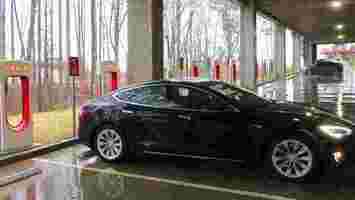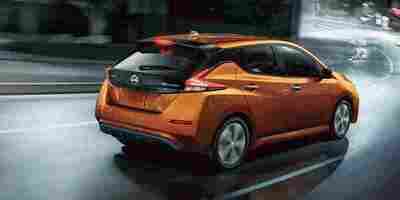Georgia unveils the first EV-charging ‘solar roadway’ in the US
This article was originally published by Sarah Wray on Cities Today , the leading news platform on urban mobility and innovation, reaching an international audience of city leaders. For the latest updates follow Cities Today on Twitter , Facebook , LinkedIn , Instagram , and YouTube , or sign up for Cities Today News.

The City of Peachtree Corners in Gwinnett County, Georgia has launched a new solar roadway system that produces energy for an electric vehicle (EV) charging station at city hall.
Separately, the city has also revealed a new EV fast-charging plaza for up to 16 vehicles. The plaza is the inaugural project in Peachtree Corners’ new EV strategy, which could serve as a model for other cities.
The solar roadway is on a section of an autonomous vehicle test lane in the city’s Curiosity Lab real-world testing environment and has been provided through a partnership with The Ray , a non-profit proving ground in Atlanta.
The new system should produce more than 1,300 kilowatt-hours of electricity annually for a Level 2 EV charger at city hall, available at no cost to EV motorists. The charger is also equipped with an energy storage system for night-time charging.
In the future, it could power streetlights and other city infrastructure, as well as back-up for grid outages, the city said.
The Wattway solar roadway panels are manufactured by French company Colas Group in partnership with the French National Solar Energy Institute .
Solar road initiatives and trials have been launched in countries such as China and France but this installation represents the first public road deployment in the US.
Brandon Branham, Chief Technology Officer and Assistant City Manager of Peachtree Corners, told Cities Today : “This application is also the first time that the solar roadway is being used as the sole power source for an electric vehicle charging station, and not just feeding the grid with supplemental power.”
Proving ground
Early results from pilots elsewhere have cast doubt on the efficacy of solar roadways. Following a three-year government-backed trial of Wattway’s panels along a kilometer-long test road in Normandy, France, reports last year said the technology wasn’t economically viable or energy efficient.
The Wattway panels have now been engineered to be more durable and efficient, which the company says has resulted in a 21 percent performance increase.
Wattway is running new trials in Normandy and also using Curiosity Lab to test the latest version. More of the panels, which are glued on, could be added to sidewalks, bike lanes , and other surfaces in the future.
On the potential to power other city infrastructure, Branham said: “This type of scale has not been proved elsewhere and is what makes this test at Curiosity Lab so invaluable, as everything from power generation to installation and maintenance will be monitored and tweaked to achieve scalability.”
Allie Kelly, Executive Director, The Ray, added: “In the near term, urban areas like Peachtree Corners might be more relevant and resilient for solar roadways deployment than highways and interstates. You can immediately pair the energy generation with important uses like charging docks for electric bikes and scooters, and even lighting and smart city infrastructure. Conversely, solar roadways at scale on interstates [are] essentially dependent on a good connection to the utility grid, which is not always present and may create significant costs for so-called ‘interconnection’.”
Taking the EV initiative
In a separate initiative, Peachtree Corners has opened a new EV fast-charging plaza that can fast-charge up to 16 vehicles simultaneously. The deployment is the first measure from the city’s new electrification plan, developed with e-mobility consultancy Hubject Consulting .
Hubject’s analysis identified that Peachtree Corners was essentially “an EV fast-charging desert,” particularly considering the growing electric vehicle ownership in and around the city. The company analyzed the city’s residential, business, and retail layout, as well as traffic patterns and electrical capacity to identify the ideal location for the charging plaza, which is situated at Peachtree Corners Town Center.
Twelve Tesla V3 Superchargers are now operational at the plaza as well as four universal charging stations. Two 350 kW chargers, and two 150 kW chargers, will go live in the new year. By early January, the plaza will be capable of charging all types of EV models. It will be one of the largest public charging facilities in the state of Georgia and the largest in the Metropolitan Atlanta area.
The chargers were funded by the charging network providers.
Model for electrification
Thomas Doran, Senior Director of Hubject North America, commented: “We hope that this project with Peachtree Corners will inspire other municipalities nationwide to actively begin planning their city’s electric vehicle infrastructure, ensuring residents and businesses are able to easily electrify.”
“More than 55,000 vehicles a day will pass by the new charging hub via the main corridor, reflecting our initiative’s immense impact on the larger region, in addition to Peachtree Corners residents,” added Brian Johnson, City Manager of Peachtree Corners. “Not only is this a significant economic driver for our city, attracting retail and other related activities, but it’s also serving as a model for other communities across the nation to follow as electrification continues to expand.”
The partnership between Hubject and Peachtree Corners is set to continue into 2021 and activities will include additional grant-funded electrification projects and other EV charging efforts.
“As one of the first real-world smart cities in the country, we pride ourselves in leading the way with ‘firsts’ – from fully autonomous electric shuttles driving alongside regular vehicles, the world’s first fleet of teleoperated e-scooters deployed for residents to now the largest EV charging hub in the entire Metro Atlanta area,” said Branham. “With the help of Hubject and our partners, we were able to create an advanced infrastructure plan that further reinforces us as a model for the American city of the future – embracing the latest emerging technologies to better the lives of residents.”
SHIFT is brought to you by Polestar. It’s time to accelerate the shift to sustainable mobility. That is why Polestar combines electric driving with cutting-edge design and thrilling performance. Find out how .
The new Nissan Leaf’s smaller price tag makes it the cheapest EV in the US
Nissan has revealed its 2022 Leaf EV, which not only comes with more standard features than last year’s model, but is priced significantly lower as well — like more than $4,000 lower.

In fact, the Leaf is now the cheapest EV in the US market, as Endgadget pointed out. And from our research that does seem to be the case, with the next car on the budget list being the 2022 Mini Cooper SE at $29,900.
Specifically, the Leaf S, the most basic model, now costs $27,400 or $28,375 including the destination charge.


Considering its pretty decent 40kWh battery, which gives it approximately 238km of range, I’d say that’s not a bad bargain at all.
The Leaf SV, which comes with the same powertrain and range, drops from $34,935 to $28,800 — an even more striking decrease of $6,135.
The same goes for the Plus editions featuring a more powerful 62kWh battery pack, which have all dropped more than $5,000.
T he longest-range (364km) S Plus costs $32,400 compared to $38,245, while the SV and SL Plus, with up to 346km of range, are now at $35,400 and $37,400, respectively.
Apart from the lower costs, Nissan is offering some more extras.
All 2022 Leafs come standard with a CHAdeMO quick charge port and a portable 240-volt charging cable.
What’s more, eight features previously included in the Technology Package of the SV Plus now become standard. ProPILOT Assist and Intelligent Around View Monitor are definitely the most notable among them.
So Nissan is reducing the prices and increasing the standard equipment. What’s going on?
On the one hand, the automaker remarks its commitment to “mass-market electric cars […] to make [the Leaf] more accessible and provide even more value to customers than ever before.”
On the other hand, the price shift seems less dramatic if we take into account the generous incentives available last year for the 2021 model — for instance, Nissan’s $7,500 rebate for cash payments.
In any case, the price drops do make an impact to potential consumers, who can get a decent EV with improved features even when on a budget.
Especially the Leaf S can cost as low as $20,875 for those who qualify for the $7,5000 federal tax credit.
I’d say, though, that the best value for money model is the SV, which is now just $1,400 more expensive than the basic S.
Do EVs excite your electrons? Do ebikes get your wheels spinning? Do self-driving cars get you all charged up?
Then you need the weekly SHIFT newsletter in your life. Click here to sign up .
Goodyear joins Michelin in launching specialist EV tires
Earlier in May, Michelin introduced the Pilot Sport EV tire, its first tire especially made to address the need of electric vehicles.

Now we have another car tire manufacturer who’s focusing on the EV industry: Goodyear. In a press release , the company announced its first EV-dedicated replacement tire in North America, the ElectricDrive GT.
Why would EVs need special tires to begin with, you ask?
Well, it all comes down to weight. Electric vehicles generally weigh more than conventional cars, which means they wear tires down much faster. Plus, worn tires will reduce the car’s range, so there’s a lot to win by preventing that from happening.
In response to that, Goodyear has created its tire with an asymmetric tread pattern and specialized tread compound, which it claims provides an enhanced all-season traction in both wet and dry road conditions.


The company has also focused on adding to the EVs’ noiseless value. The ElectricDrive GT features Goodyear’s SoundComfort Technology, which “acts as a built-in sound barrier that helps reduce road noise.”
And while Michelin has already launched its Pilot Sport EV in various sizes in Europe and North America, Goodyear will initially offer its tire in size 255/45R19 104W XL, which it says fits to some of the most popular EV high-performance models.
Plans to expand the ElectricDrive GT’s portofolio are underway for 2022.
Talking about tires isn’t really interesting, but what’s striking here is that we’re witnessing a shift to EVs not only by automakers, but also by other industries affiliated with the auto world.
Check out the statement of Andrew Lau, Goodyear’s product marketing manager:
Yes, folks, things are changing . The EV segment might still be a minority in selling and ownership numbers, but its increasing traction has nevertheless put it in the auto map as specific entity with individual needs and market requirements.
Well, this makes me very hopeful about how soon we can embark on an electric future.